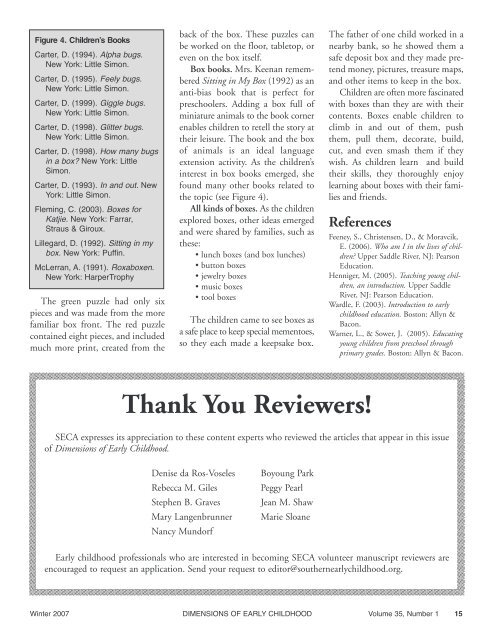Dimensions of Early Childhood - Southern Early Childhood ...
Dimensions of Early Childhood - Southern Early Childhood ...
Dimensions of Early Childhood - Southern Early Childhood ...
Create successful ePaper yourself
Turn your PDF publications into a flip-book with our unique Google optimized e-Paper software.
Figure 4. Children’s Books<br />
Carter, D. (1994). Alpha bugs.<br />
New York: Little Simon.<br />
Carter, D. (1995). Feely bugs.<br />
New York: Little Simon.<br />
Carter, D. (1999). Giggle bugs.<br />
New York: Little Simon.<br />
Carter, D. (1998). Glitter bugs.<br />
New York: Little Simon.<br />
Carter, D. (1998). How many bugs<br />
in a box? New York: Little<br />
Simon.<br />
Carter, D. (1993). In and out. New<br />
York: Little Simon.<br />
Fleming, C. (2003). Boxes for<br />
Katjie. New York: Farrar,<br />
Straus & Giroux.<br />
Lillegard, D. (1992). Sitting in my<br />
box. New York: Puffin.<br />
McLerran, A. (1991). Roxaboxen.<br />
New York: HarperTrophy<br />
The green puzzle had only six<br />
pieces and was made from the more<br />
familiar box front. The red puzzle<br />
contained eight pieces, and included<br />
much more print, created from the<br />
back <strong>of</strong> the box. These puzzles can<br />
be worked on the floor, tabletop, or<br />
even on the box itself.<br />
Box books. Mrs. Keenan remembered<br />
Sitting in My Box (1992) as an<br />
anti-bias book that is perfect for<br />
preschoolers. Adding a box full <strong>of</strong><br />
miniature animals to the book corner<br />
enables children to retell the story at<br />
their leisure. The book and the box<br />
<strong>of</strong> animals is an ideal language<br />
extension activity. As the children’s<br />
interest in box books emerged, she<br />
found many other books related to<br />
the topic (see Figure 4).<br />
All kinds <strong>of</strong> boxes. As the children<br />
explored boxes, other ideas emerged<br />
and were shared by families, such as<br />
these:<br />
• lunch boxes (and box lunches)<br />
• button boxes<br />
• jewelry boxes<br />
• music boxes<br />
• tool boxes<br />
The children came to see boxes as<br />
a safe place to keep special mementoes,<br />
so they each made a keepsake box.<br />
The father <strong>of</strong> one child worked in a<br />
nearby bank, so he showed them a<br />
safe deposit box and they made pretend<br />
money, pictures, treasure maps,<br />
and other items to keep in the box.<br />
Children are <strong>of</strong>ten more fascinated<br />
with boxes than they are with their<br />
contents. Boxes enable children to<br />
climb in and out <strong>of</strong> them, push<br />
them, pull them, decorate, build,<br />
cut, and even smash them if they<br />
wish. As children learn and build<br />
their skills, they thoroughly enjoy<br />
learning about boxes with their families<br />
and friends.<br />
References<br />
Feeney, S., Christensen, D., & Moravcik,<br />
E. (2006). Who am I in the lives <strong>of</strong> children?<br />
Upper Saddle River, NJ: Pearson<br />
Education.<br />
Henniger, M. (2005). Teaching young children,<br />
an introduction. Upper Saddle<br />
River, NJ: Pearson Education.<br />
Wardle, F. (2003). Introduction to early<br />
childhood education. Boston: Allyn &<br />
Bacon.<br />
Warner, L., & Sower, J. (2005). Educating<br />
young children from preschool through<br />
primary grades. Boston: Allyn & Bacon.<br />
Thank You Reviewers!<br />
SECA expresses its appreciation to these content experts who reviewed the articles that appear in this issue<br />
<strong>of</strong> <strong>Dimensions</strong> <strong>of</strong> <strong>Early</strong> <strong>Childhood</strong>.<br />
Denise da Ros-Voseles<br />
Rebecca M. Giles<br />
Stephen B. Graves<br />
Mary Langenbrunner<br />
Nancy Mundorf<br />
Boyoung Park<br />
Peggy Pearl<br />
Jean M. Shaw<br />
Marie Sloane<br />
<strong>Early</strong> childhood pr<strong>of</strong>essionals who are interested in becoming SECA volunteer manuscript reviewers are<br />
encouraged to request an application. Send your request to editor@southernearlychildhood.org.<br />
Winter 2007 DIMENSIONS OF EARLY CHILDHOOD Volume 35, Number 1 15

















